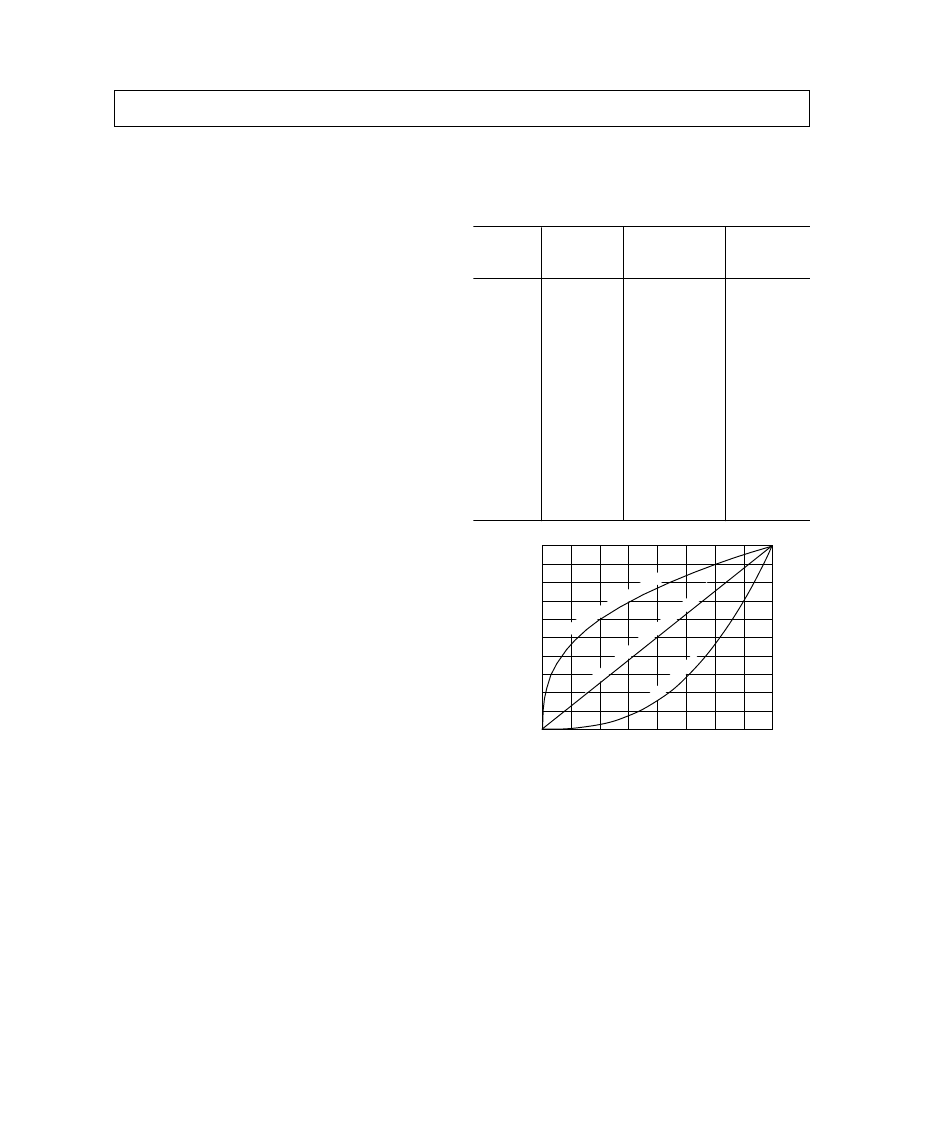- 您現(xiàn)在的位置:買(mǎi)賣(mài)IC網(wǎng) > PDF目錄374046 > ADV7160KS220 (ANALOG DEVICES INC) 96-Bit, 220 MHz True-Color Video RAM-DAC PDF資料下載
參數(shù)資料
| 型號(hào): | ADV7160KS220 |
| 廠商: | ANALOG DEVICES INC |
| 元件分類: | 顯示控制器 |
| 英文描述: | 96-Bit, 220 MHz True-Color Video RAM-DAC |
| 中文描述: | 1600 X 1200 PIXELS PALETTE-DAC DSPL CTLR, PQFP160 |
| 封裝: | THERMALLY ENHANCED, PLASTIC, QFP-160 |
| 文件頁(yè)數(shù): | 37/44頁(yè) |
| 文件大小: | 668K |
| 代理商: | ADV7160KS220 |
第1頁(yè)第2頁(yè)第3頁(yè)第4頁(yè)第5頁(yè)第6頁(yè)第7頁(yè)第8頁(yè)第9頁(yè)第10頁(yè)第11頁(yè)第12頁(yè)第13頁(yè)第14頁(yè)第15頁(yè)第16頁(yè)第17頁(yè)第18頁(yè)第19頁(yè)第20頁(yè)第21頁(yè)第22頁(yè)第23頁(yè)第24頁(yè)第25頁(yè)第26頁(yè)第27頁(yè)第28頁(yè)第29頁(yè)第30頁(yè)第31頁(yè)第32頁(yè)第33頁(yè)第34頁(yè)第35頁(yè)第36頁(yè)當(dāng)前第37頁(yè)第38頁(yè)第39頁(yè)第40頁(yè)第41頁(yè)第42頁(yè)第43頁(yè)第44頁(yè)

ADV7160/ADV7162
REV. 0
–37–
GAMMA CORRECTION
8 Bits vs. 10 Bits
Gamma
Corrected
(2.7)
Quantized to
8 Bits
Quantized to
10 Bits
8-Bit Data
240
241
242
243
244
245
246
247
248
249
250
251
252
253
254
255
0.977797
0.979304
0.980807
0.982306
0.983801
0.985292
0.986780
0.988264
0.989744
0.991220
0.992693
0.994161
0.995626
0.997088
0.998546
1.000000
250
250
251
251
251
252
252
252
253
253
254
254
254
255
255
255
1001
1002
1004
1005
1007
1008
1010
1011
1013
1015
1016
1018
1019
1021
1022
1023
INPUT CODE – DECIMAL
D
1.00
0.20
0
256
32
64
96
128
160
192
224
0.90
0.60
0.50
0.40
0.30
0.80
0.70
GAMMACORRECTONCURVE
CRTRESPONSE
LNEARRESPONSERECEVEDBYTHEEYE
0.00
0.10
Gamma Correction Curve (Gamma Value = 2.7)
APPENDIX 3
10-BIT DACs AND GAMMA CORRECTION
10-Bit DACs
10-Bit RAM-DAC resolution allows for nonlinear video correc-
tion, in particular Gamma Correction. The ADV7160/ADV7162
allows for an increase in color resolution from 24-bit to 30-bit
effective color without the necessity of a 30-bit deep frame
buffer. In true-color mode, for example, the part effectively op-
erates as a 24-bit to 30-bit color look-up table.
Up to now we have assumed that there exists a linear relation-
ship between the actual RGB values input to a monitor and the
intensity produced on the screen. This, however, is not the
case. Half scale digital input (1000 0000) might correspond to
only 20% output intensity on the CRT (Cathode Ray Tube).
The intensity (I
CRT
) produced on a CRT by an input value I
IN
is
given by:
I
CRT
=
(
I
IN
)
c
where
c
ranges from 2.0 to 2.8.
If the individual values of c for red, green and blue are known,
then so called “Gamma Correction” can be applied to each of
the three video input signals (I
IN
); therefore:
I
IN
(
corrected
)
=
k
(
I
IN
)
1
/
c
Traditionally, there has been a trade-off between implementing
a nonlinear graphics function, such as gamma correction, and
color dynamic range. The ADV7160/ADV7162 overcomes this
by increasing the individual color resolution of each of the red,
green and blue primary colors from 8 bits per color channel to
10 bits per channel (24 bits to 30 bits).
The table highlights the loss of resolution when 8-bit data is
gamma-corrected to a value of 2.7 and quantized in a traditional
8-bit system. Note that there is no change in the 8-bit quan-
tized data for linear changes in the input data over much of the
transfer function. On the other hand, when quantized to 10 bits
via the 10-bit RAMs and 10-bit DACs of the ADV7160/
ADV7162, all changes on the input 8-bit data are reflected in
corresponding changes in the 10-bit data.
The graph shows a typical gamma curve corresponding to a
gamma value of 2.7. This is programmed to the red, green and
blue RAMs of the color look-up table instead of the more tradi-
tional linear function. Different curves corresponding to any
particular gamma value can be independently programmed to
each of the red, green and blue RAMs.
Other applications of the 10-bit RAM-DAC include closed-loop
monitor color calibration.
相關(guān)PDF資料 |
PDF描述 |
|---|---|
| ADV7170 | Digital PAL/NTSC Video Encoder with 10-Bit SSAF⑩ and Advanced Power Management |
| ADV7170KS | Digital PAL/NTSC Video Encoder with 10-Bit SSAF⑩ and Advanced Power Management |
| ADV7170SU | Digital PAL/NTSC Video Encoder with 10-Bit SSAF⑩ and Advanced Power Management |
| ADV7171KS | Digital PAL/NTSC Video Encoder with 10-Bit SSAF⑩ and Advanced Power Management |
| ADV7171SU | Digital PAL/NTSC Video Encoder with 10-Bit SSAF⑩ and Advanced Power Management |
相關(guān)代理商/技術(shù)參數(shù) |
參數(shù)描述 |
|---|---|
| ADV7162 | 制造商:AD 制造商全稱:Analog Devices 功能描述:96-Bit, 220 MHz True-Color Video RAM-DAC |
| ADV7162KS140 | 制造商:Rochester Electronics LLC 功能描述: 制造商:Analog Devices 功能描述: |
| ADV7162KS170 | 制造商:AD 制造商全稱:Analog Devices 功能描述:96-Bit, 220 MHz True-Color Video RAM-DAC |
| ADV7162KS220 | 制造商:Analog Devices 功能描述:DAC 3-CH Segment 10-bit 160-Pin MQFP 制造商:Rochester Electronics LLC 功能描述:220 MHZ VIDEO RAM DAC I.C. - Bulk |
| ADV7162KSZ140 | 制造商:Analog Devices 功能描述:DAC 3-CH Segment 10-bit 160-Pin MQFP |
發(fā)布緊急采購(gòu),3分鐘左右您將得到回復(fù)。